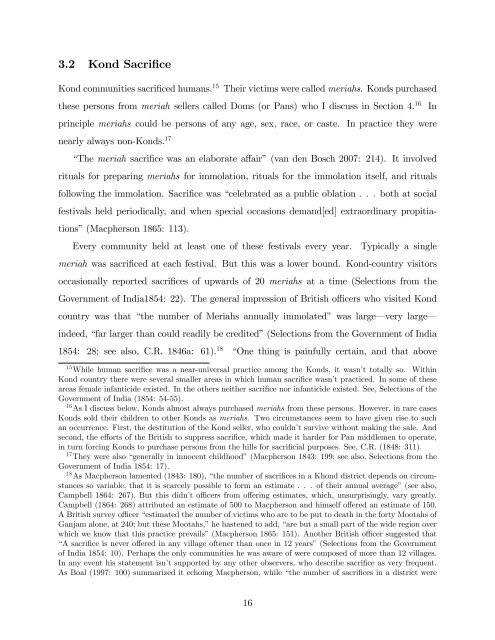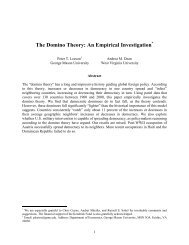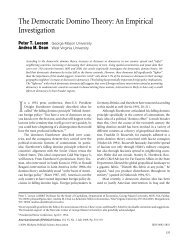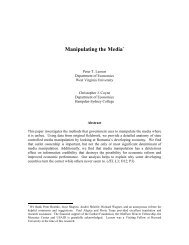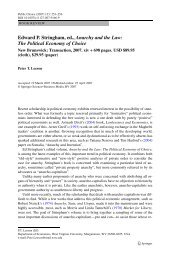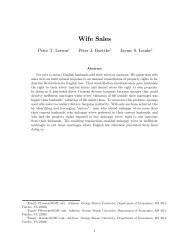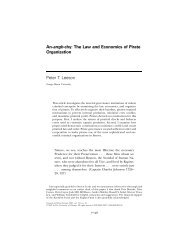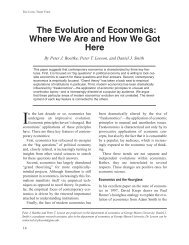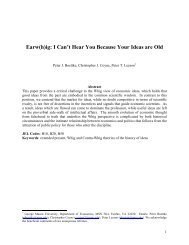Human Sacrifice - Peter Leeson
Human Sacrifice - Peter Leeson
Human Sacrifice - Peter Leeson
You also want an ePaper? Increase the reach of your titles
YUMPU automatically turns print PDFs into web optimized ePapers that Google loves.
3.2 Kond Sacri…ce<br />
Kond communities sacri…ced humans. 15 Their victims were called meriahs. Konds purchased<br />
these persons from meriah sellers called Doms (or Pans) who I discuss in Section 4. 16<br />
principle meriahs could be persons of any age, sex, race, or caste. In practice they were<br />
nearly always non-Konds. 17<br />
“The meriah sacri…ce was an elaborate a¤air” (van den Bosch 2007: 214). It involved<br />
rituals for preparing meriahs for immolation, rituals for the immolation itself, and rituals<br />
following the immolation. Sacri…ce was “celebrated as a public oblation . . . both at social<br />
festivals held periodically, and when special occasions demand[ed] extraordinary propitiations”(Macpherson<br />
1865: 113).<br />
Every community held at least one of these festivals every year.<br />
In<br />
Typically a single<br />
meriah was sacri…ced at each festival. But this was a lower bound. Kond-country visitors<br />
occasionally reported sacri…ces of upwards of 20 meriahs at a time (Selections from the<br />
Government of India1854: 22). The general impression of British o¢ cers who visited Kond<br />
country was that “the number of Meriahs annually immolated” was large— very large—<br />
indeed, “far larger than could readily be credited”(Selections from the Government of India<br />
1854: 28; see also, C.R. 1846a: 61). 18 “One thing is painfully certain, and that above<br />
15 While human sacri…ce was a near-universal practice among the Konds, it wasn’t totally so. Within<br />
Kond country there were several smaller areas in which human sacri…ce wasn’t practiced. In some of these<br />
areas female infanticide existed. In the others neither sacri…ce nor infanticide existed. See, Selections of the<br />
Government of India (1854: 54-55).<br />
16 As I discuss below, Konds almost always purchased meriahs from these persons. However, in rare cases<br />
Konds sold their children to other Konds as meriahs. Two circumstances seem to have given rise to such<br />
an occurrence. First, the destitution of the Kond seller, who couldn’t survive without making the sale. And<br />
second, the e¤orts of the British to suppress sacri…ce, which made it harder for Pan middlemen to operate,<br />
in turn forcing Konds to purchase persons from the hills for sacri…cial purposes. See, C.R. (1848: 311).<br />
17 They were also “generally in innocent childhood”(Macpherson 1843: 199; see also, Selections from the<br />
Government of India 1854: 17).<br />
18 As Macpherson lamented (1843: 180), “the number of sacri…ces in a Khond district depends on circumstances<br />
so variable, that it is scarcely possible to form an estimate . . . of their annual average” (see also,<br />
Campbell 1864: 267). But this didn’t o¢ cers from o¤ering estimates, which, unsurprisingly, vary greatly.<br />
Campbell (1864: 268) attributed an estimate of 500 to Macpherson and himself o¤ered an estimate of 150.<br />
A British survey o¢ cer “estimated the number of victims who are to be put to death in the forty Mootahs of<br />
Ganjam alone, at 240; but these Mootahs,”he hastened to add, “are but a small part of the wide region over<br />
which we know that this practice prevails”(Macpherson 1865: 151). Another British o¢ cer suggested that<br />
“A sacri…ce is never o¤ered in any village oftener than once in 12 years” (Selections from the Government<br />
of India 1854: 10). Perhaps the only communities he was aware of were composed of more than 12 villages.<br />
In any event his statement isn’t supported by any other observers, who describe sacri…ce as very frequent.<br />
As Boal (1997: 100) summarized it echoing Macpherson, while “the number of sacri…ces in a district were<br />
16


